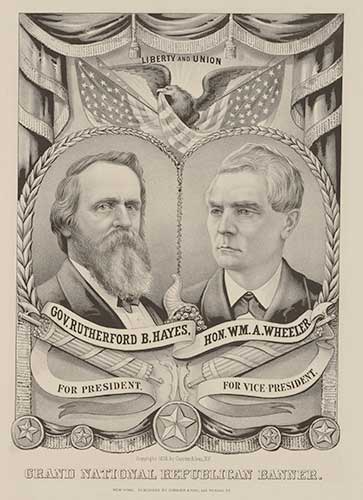Learn
Depression of 1873
The Republicans were blamed for the Depression of 1873, resulting in the Democrats winning the House of Representatives in the next election. Because of the economic chaos and panic, Northerners were more concerned with their own financial problems and tired of the military occupation of the South.
Compromise of 1877
Remember, Reconstruction was a Republican cause. When the Republicans lost their majority in Congress, they could no longer insist on civil and political equality. In addition, Democrats had steadily gained control of the South. Most of the southern Republicans had been driven out of the South by the Ku Klux Klan and other terrorists organizations. The US Supreme Court began weakening the Civil War Amendments and Civil Rights Acts by ruling that they only protected citizens on the federal level, not the state level.
Republicans would now have to compromise with Democrats on several issues, including Reconstruction and even the Presidential Election of 1876. The compromise, referred to as the Compromise of 1877, was extremely important because it ended Reconstruction.
Unlike other compromises, this was not a law or a group of acts. The Compromise of 1877 was an agreement between the two major parties.
Presidential Election of 1876
The Compromise of 1877 was the result of the 1876 presidential election. The Democratic Party nominated Samuel J. Tilden, who won 184 electoral votes and led the popular vote by about 250,000.
The Republican Party nominated Rutherford B. Hayes, who won 165 electoral votes and lost the popular vote.


It took 185 electoral votes to win the presidency; Tilden was one vote short.
Hayes was a former Union general, the governor of Ohio, and hadn't offended anyone!
The 1876 election results from Florida, South Carolina, and Louisiana were disputed.
Normal procedure was for the votes to be recounted in front of Congress. However, the President of the Senate was a Republican and the Speaker of the House was a Democrat – and neither party trusted the other in a fair count of the votes.
Congress decided to establish a special committee to count the votes. This Electoral Count Act Committee had 15 members: 5 Congressmen, 5 Senators, and 5 Supreme Court Justices
This group consisted of 7 Republicans, 7 Democrats, and one Independent who refused to serve and was replaced by a moderate Republican.
The election committee met, but the real "deal" was going on between Hayes's Republican allies and the Southern Democrats.
Conditions of the Compromise
Conditions of the Compromise of 1877 included:
- Democrats agreed to Hayes becoming president and promised to respect the political and civil rights of African Americans
- Republicans agreed to withdraw all federal troops from the South, thus ensuring the Democrats' control there.
- Hayes agreed to name a leading southerner to his cabinet
- Hayes also agreed to grant federal aid for a transcontinental railroad route in the south
- It ended Reconstruction and left African Americans on their own.